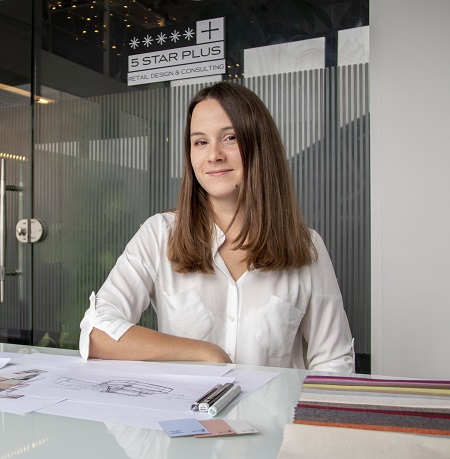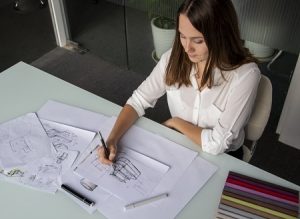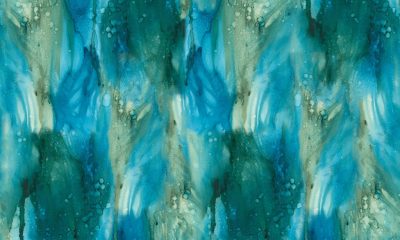In continuation of our celebration of International Women’s history month, this article highlights one of our Senior Designers at 5 Star Plus Retail Design, Olga. She is an experienced architect and retail designer working with both Chinese and European companies that come for different retail sectors including, fashion retail, FMCG, consumer electronics and more.
To fully understand her role, Olga describes a retail designer as working in-between two worlds: world of interior design and world of marketing. As a retail designer she aims to not only create functional, comfortable, and beautiful space for people but also depict and fulfill business goals of each client. This can be a challenge when working with a variety of different commercial projects. She takes pride in focusing on the brand’s vision, positioning, and sales strategy and translating this message creatively into the physical space. The main goal of her design creations is to deliver this message to customers while also enabling them to have a unique and memorable experience.
This week we asked Olga to share her design insights for creating impactful designs in the Chinese market.
Q: How can retail design affect the sales performance of a store?
A: There is no denying that retail design has a direct influence on a store’s financial success. By using retail design instruments we can improve customer experience, change the market positioning of the brand, as well as attract attention to the retailer’s services and brand story. The design details of a retail store should be thoughtfully incorporated to ultimately encourage slow-shopping and keep customers inside the store longer by encouraging interaction and testing of their products. The longer a customer stays in the store, the more likely they are to buy products. As a result, a well designed brick-and-mortar store can help to not only increase sales but also bring long-term brand loyalty of customers.
Q: Please describe some of the techniques you use to attract customers into a store.
A: It is important to create barrier-free access to the store to encourage people come inside and shop. By creating a broad open entrance, the retail environment becomes more welcoming for customers. Brands can also place a video screen, or attention grabbing display with the selected products at the store entrance.
Q: Analysis is the first step when creating a retail store design. Why is analysis so important when creating a new store design concept?
A: It is impossible to find a solution to the problem without first objectively understanding the current market and customer needs. There are numerous different methods on how to depict and analyze business processes and their customers which can be done by observation, questionnaires or data analysis. Only by understanding friction points in current design format, and identifying clear goals for the new concept, can we create a new successful design concept for the brand.
Advertisement
Q: As a retail design professional, how do you express a brand identity in a 3D environment?
A: Like every designer I have a toolbox of colors, shapes, textures and light. However, as a retail designer, I have the unique ability to design interaction points between the customer and the brand. I believe that the experience that customers have in the store can truly define brand identity.
Q: In this fast-paced world, what retail design formats do you think are important for brands?
A: Generally all the formats should be customer centered. Now the border between formats is blurred. Online retailers are going offline and vice versa with the goal of making their stores more efficient and convenient for the customer. This gives brands the challenge of finding more ways to reach customers. For this reason, traditional brands are implementing creative pop-up stores, experimenting with differentiating services in stores to meet the needs of their customers. Brands are now integrating experience spaces into their retail store design including, coffee corners, providing space for things like yoga classes, and building collaborations with KOLs.
Q: As a retail designer, what are important technological aspects that can be integrated into store designs? What do you think of shopping with AR?
A: In the new era of electronic technologies and e-commerce platforms, brick-and-mortar retailers should adopt and consider implementation of new retail strategy into store design to create a more seamless experience between online and offline brand representation. Brick-and-mortar retail stores can consider to integrate tablets, and other interactive technologies into the store design that link their clients to the online platforms in a meaningful way.
The idea of AR technologies being incorporated into the shopping experience for consumers has been heavily investigated by retailers in recent years. While some brands still struggle to identify a meaningful strategy for implanting this type of technology, other of the brands, like Zara have already integrated AR into their brick-and-mortar stores. Other brands are using AR as a supporting instrument in their loyalty programs.
Q: When you walk through shopping malls in China, are the things you notice that most brands do not do well enough when designing their stores?
A: I think retailers in China are doing amazing work in terms of retail design. However, the design layout for lighting can be improved for some stores.
Advertisement
Q: What are the differences in retail design between the Chinese and the European markets? What can these markets learn from each other in terms of enhancing the overall retail experience for consumers?
A: It’s no secret that China is far ahead of Europe in terms of online shopping. In Europe, a lot of retailers are only just beginning to put a stronger focus on increasing online sales. Currently, online sales account for 4% of overall retail sales in the European market. For this reason, European retailers are implementing offline pick-up points in stores for online orders. This allows customers to have an easier and convenient shopping experience.
Offline shopping in the European market tends to be more competitive than in the Chinese market. In the Chinese market, many European retailers are more willing to experiment with unique retail designs compared to Chinese retailers. As the result a lot of interesting retail concepts have appeared recently.
Nowadays a fundamental design trend is providing experience for the customers. Consumers are not only going to the store to buy goods, they also seek emotion to be generated by interacting with the brand through retail experience. Retailers are trying to provide this additional value to consumers. Right now, I would say that China is leading this phenomena and setting retail design trends in this regard. The practice of new retail design, with a heavy focus on experience and creative design, is one thing that the European market can learn from China’s retail market.


 Photo Gallery1 week ago
Photo Gallery1 week ago
 Headlines4 days ago
Headlines4 days ago
 Headlines1 week ago
Headlines1 week ago
 Headlines2 weeks ago
Headlines2 weeks ago
 Headlines1 week ago
Headlines1 week ago
 Designer Dozen1 week ago
Designer Dozen1 week ago
 Headlines1 week ago
Headlines1 week ago
 Headlines1 week ago
Headlines1 week ago























